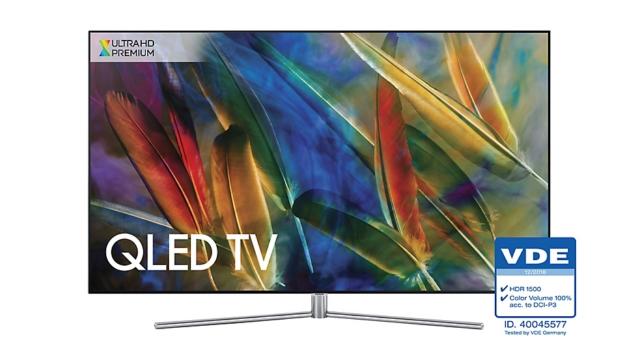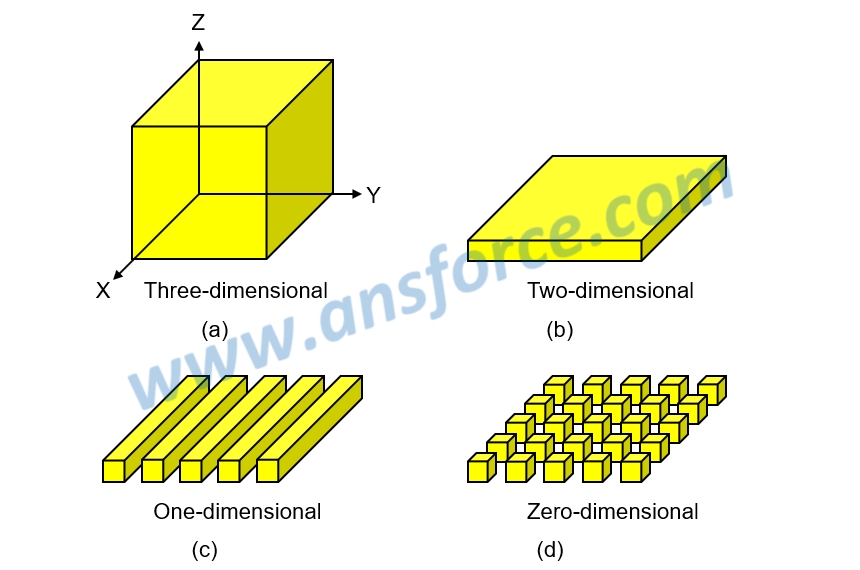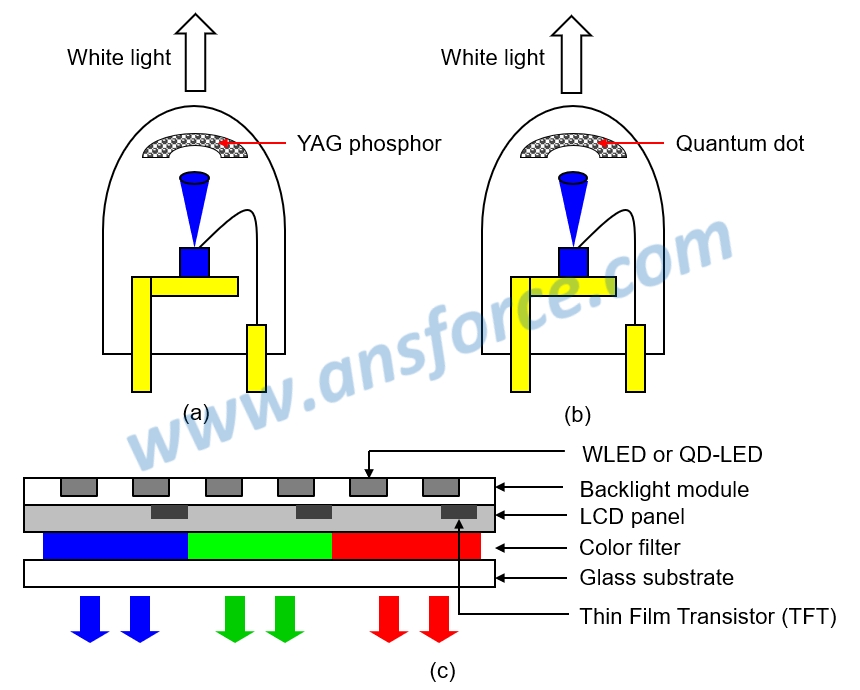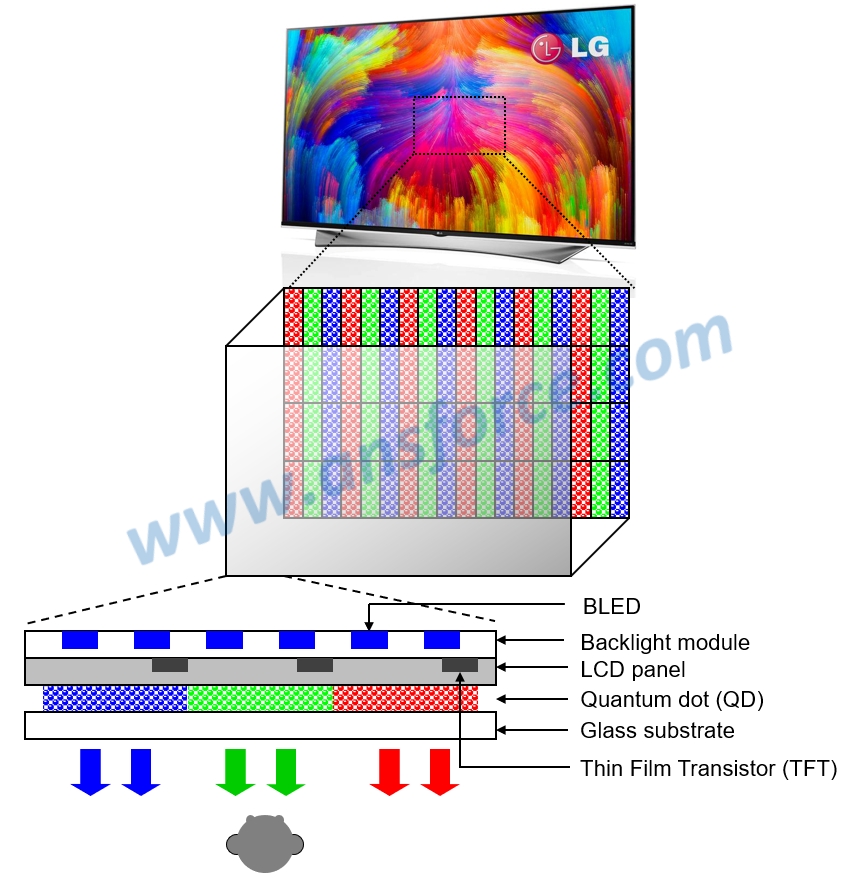文章內容
Quantum Dot TV (QD-TV)


❒ Quantum confinement effect
Scientists discovered that when the dimension of material is less than 10 nm, it will generate Quantum confinement effect. At this tie, the electrons and the electron holes will be confined in the nano-material to form a self-constructed steady state causing the change of light emitting property. Besides, when the dimension of nano-material gets smaller, the light emitting strength of the material will be stronger and the wavelength of the emitted light will become shorter (blue). The effect is called “Blue shift” as shown in Fig. 1.
The light with different colors has different wavelengths, so the wavelength of light represents its color. In visible light, the red light has the longest wavelength, the green light comes the second, and the blue light has the shortest wavelength. In other words, if the dimension of nano-material is large, the light emitting strength will be weaker and the color will be red (having longest wavelength); if the dimension of nano-material becomes smaller, the light emitting strength will become stronger and the color will be green (having the next longest wavelength); and, if the dimension of nano-material becomes further smaller, the light emitting strength will become more stronger and the color will be blue (having the shortest wavelength).
.jpg)
Figure 1: Blue shift of quantum confinement effect.
Source: Tae-Ho Kim et al., Heterogeneous stacking of nanodot monolayers by dry pick-and-place transfer and its applications in quantum dot light-emitting diodes, Nature Communications, Article number: 2637, Published 06 November 2013.
❒ Quantum Dots (QD)
A normal size of material may be usually called a “bulk” that the structure may be infinitely extended along X-axis, Y-axis and Z-axis in a three-dimensional space, as shown in Fig. 1(a). The nano-material may be simply classified by the geometric structure of the appearance as Two-dimensional, One-dimensional, and Zero-dimensional, described as follows:
➤ Two-dimensional: X-axis and Y-axis may be infinitely extended, but Z-axis is very small (less than 100nm), as shown in Fig. 1(b). The two-dimensional nano-structure is called “Nano thin film” or “Quantum well.”
➤ One-dimensional: X-axis may be infinitely extended, but Y-axis and Z-axis are both very small (less than 100nm), as shown in Fig. 1(c). For one-dimensional nano-structure, the longer one is called “Nanowires,” and the shorter one is called “Nanorods,” and the hollow one is called “Nanotube.”
➤ Zero-dimensional: X-axis, Y-axis, and Z-axis are all very small, as shown in Fig. 1(d). The zero-dimensional structure is called “Nanoparticles” or “Quantum dots.”

Figure 2: Geometric structure of nano-material.
❒ QD-LED
The principle of light emitting for conventional White (WLED) is to utilize Blue LED (BLED) dies to emit blue light onto YAG phosphor that the phosphor may absorb the blue light to generate white light, as shown in Fig. 3(a). Because the RGB colors of this type of device are limited, the colors that may be composed are still not enough. Thus, the Quantum Dots (QD) are applied to replace phosphor to generate three colors, i.e. red, green and blue, to be mixed as white light, so-called Quantum Dot Light Emitting Diode (QD-LED), as shown in Fig. 3(b).
QD-LED may be used as the backlight source of LCD, as shown in Fig. 3(c), which may increase the RGB colors and may increase the colors that may be composed after passing the color filter. There is no need of modifying too much the structure of LCD and the cost is the lowest, but QD-LED still needs to use the color filter.

Figure 3: Structure of QD-LED.
❒ Quantum Dot TV (QD-TV)
In order to further increase the RGB colors, the BLED may be used as the backlight source, as shown in Fig. 4. The liquid crystal panel is used for imaging, and the quantum dots are directly printed on the panel to form different sub-pixels for replacing the color filter. By irradiation of blue light backlight module, the red quantum dots may absorb the blue light to emit red light, the green quantum dots may absorb the blue light to emit green light, and the blue quantum dots may absorb the blue light to emit blue light, wherein the blue pixels may not use blue quantum dots because the blue pixels have the same color as the backlight module. The structure of QD-TV is shown in Fig. 4.

Figure 4: Structure of QD-TV.
Source: www.lg.com/ae/tvs/lg-79UH953V-super-uhd-tv.
【Remark】The aforementioned contents have been appropriately simplified to be suitable for reading by the public, which might be slightly differentiated from the current industry situation. If you are the expert in this field and would like to give your opinions, please contact the writer. If you have any industrial and technical issues, please join the community for further discussion.
